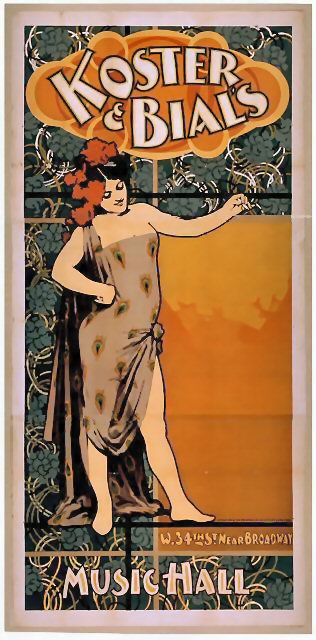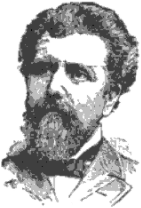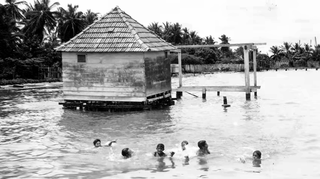The following is an overview of the events of 1896 in film, including a list of films released and notable births.
The following is an overview of the events of 1894 in film, including a list of films released and notable births.

The Kinetoscope is an early motion picture exhibition device, designed for films to be viewed by one person at a time through a peephole viewer window. The Kinetoscope was not a movie projector, but it introduced the basic approach that would become the standard for all cinematic projection before the advent of video: it created the illusion of movement by conveying a strip of perforated film bearing sequential images over a light source with a high-speed shutter. First described in conceptual terms by U.S. inventor Thomas Edison in 1888, it was largely developed by his employee William Kennedy Laurie Dickson between 1889 and 1892. Dickson and his team at the Edison lab in New Jersey also devised the Kinetograph, an innovative motion picture camera with rapid intermittent, or stop-and-go, film movement, to photograph movies for in-house experiments and, eventually, commercial Kinetoscope presentations.

The Kiss is an 1896 film, and was one of the first films ever shown commercially to the public. Around 18 seconds long, it depicts a re-enactment of the kiss between May Irwin and John Rice from the final scene of the stage musical The Widow Jones. The film was directed by William Heise for Thomas Edison. The film was produced in April 1896 at the Edison Studios of Edison, the first film studio in the United States. At the time, Edison was working at the Black Maria studios in West Orange, New Jersey.

Vitascope was an early film projector first demonstrated in 1895 by Charles Francis Jenkins and Thomas Armat. They had made modifications to Jenkins' patented Phantoscope, which cast images via film and electric light onto a wall or screen. The Vitascope is a large electrically-powered projector that uses light to cast images. The images being cast are originally taken by a kinetoscope mechanism onto gelatin film. Using an intermittent mechanism, the film negatives produced up to fifty frames per second. The shutter opens and closes to reveal new images. This device can produce up to 3,000 negatives per minute. With the original Phantoscope and before he partnered with Armat, Jenkins displayed the earliest documented projection of a filmed motion picture in June 1894 in Richmond, Indiana.

The Monroe Doctrine is a United States foreign policy position that opposes European colonialism in the Western Hemisphere. It holds that any intervention in the political affairs of the Americas by foreign powers is a potentially hostile act against the United States. The doctrine was central to American grand strategy in the 20th century.

Koster and Bial's Music Hall was an important vaudeville theatre in New York City, located at Broadway and Thirty-Fourth Street, where Macy's flagship store now stands. It had a seating capacity of 3,748, twice the size of many theaters. Ticket prices ranged from 25¢ for a seat in the gallery to $1.50 for one in the orchestra. The venue was founded by John Koster (1844-1895) and Albert Bial (1842-1897) in the late 19th century and closed in 1901.

William Lindsay Scruggs was an American author, lawyer, and diplomat. He was a scholar of South American foreign policy and U.S. ambassador to Colombia and Venezuela. He played a key role in the Venezuela Crisis of 1895 and helped shape the modern interpretation of the Monroe Doctrine.

The Corbett-Fitzsimmons Fight is an 1897 documentary film directed by Enoch J. Rector depicting the 1897 boxing match between James J. Corbett and Bob Fitzsimmons in Carson City, Nevada on St. Patrick's Day. Originally running for more than 100 minutes, it was the longest film released to date; as such, it was the world's first feature film.
Charles John Musser is a film historian, documentary filmmaker, and a film editor. Since 1992, he has taught at Yale University, where he is currently a professor of Film and Media Studies as well as American Studies and Theater Studies. His research has primarily focused on early cinema, and topics such as Edwin S. Porter, Oscar Micheaux, race cinema of the silent era, Paul Robeson, film performance, as well as a variety of issues and individuals in documentary. His films include An American Potter (1976), Before the Nickelodeon: The Early Cinema of Edwin S. Porter (1982) and Errol Morris: A Lightning Sketch (2014).

The Venezuelan crisis of 1895 occurred over Venezuela's longstanding dispute with Great Britain about the territory of Essequibo, which Britain believed was part of British Guiana and Venezuela recognized as its own Guayana Esequiba. As the dispute became a crisis, the key issue became Britain's refusal to include in the proposed international arbitration the territory east of the "Schomburgk Line", which a surveyor had drawn half-a-century earlier as a boundary between Venezuela and the former Dutch territory ceded by the Dutch in the Anglo-Dutch Treaty of 1814, later part of British Guiana. The crisis ultimately saw Britain accept the United States' intervention in the dispute to force arbitration of the entire disputed territory, and tacitly accept the US right to intervene under the Monroe Doctrine. A tribunal convened in Paris in 1898 to decide the matter, and in 1899 awarded the bulk of the disputed territory to British Guiana.

The cinema of Venezuela is the production and industry of filmmaking in Venezuela. Venezuelan cinema has been characterised from its outset as propaganda, partially state-controlled and state-funded, commercial cinema. The nation has seen a variety of successful films, which have reaped several international awards. Still, in terms of quality, it is said that though "we can point to specific people who have made great films in Venezuela [and] a couple of great moments in the history of Venezuelan cinema, [...] those have been exceptions". In the 21st century, Venezuelan cinema has seen more independence from the government, but has still been described as recently as 2017 to be at least "influenced" by the state.

This article delineates the history of cinema in the United States

Manuel Trujillo Durán was a Venezuelan photographer who pioneered film in Venezuela. Trujillo was most successful as a photographer, though he dabbled in other industries and is best remembered for his connections to the fledgling film industry in Venezuela. He became one of the first people from Latin America to learn how to show films; he was thought for many years to be the director of Venezuela's first films, and traveled through Venezuela and Colombia with projectors to introduce cinema to this part of the South American continent.

Un célebre especialista sacando muelas en el gran Hotel Europa was the first Venezuelan film. It was screened at the Baralt Theatre in Maracaibo, Zulia on 28 January 1897 as the second in a film block of four; the block also featured another film from Maracaibo. Little is known about the film's production, and scholars are uncertain of the identity of its director.

Muchachos bañándose en la laguna de Maracaibo is the second Venezuelan film produced, after Un célebre especialista sacando muelas en el gran Hotel Europa. It was screened at the Baralt Theatre in Maracaibo, Venezuela, on 28 January 1897.
Luis Manuel Méndez was a Venezuelan businessman and film presenter from the state of Zulia.
Venezuela was introduced to cinema as a for-profit industry in the 1890s, when the medium became international. There were at least eight national films made in the decade, by three groups of filmmakers — one of the groups was based in Maracaibo and one was based in Caracas. The first film screening in the nation may have taken place as early as 1894, but is generally reported as 1896, with this later date being the first scheduled public screening.

Norman C. Raff and Frank R. Gammon were two American businessmen who were known for distributing and promoting some of the Edison Studio films, and founding their own business, which was called The Kinetoscope Company.













